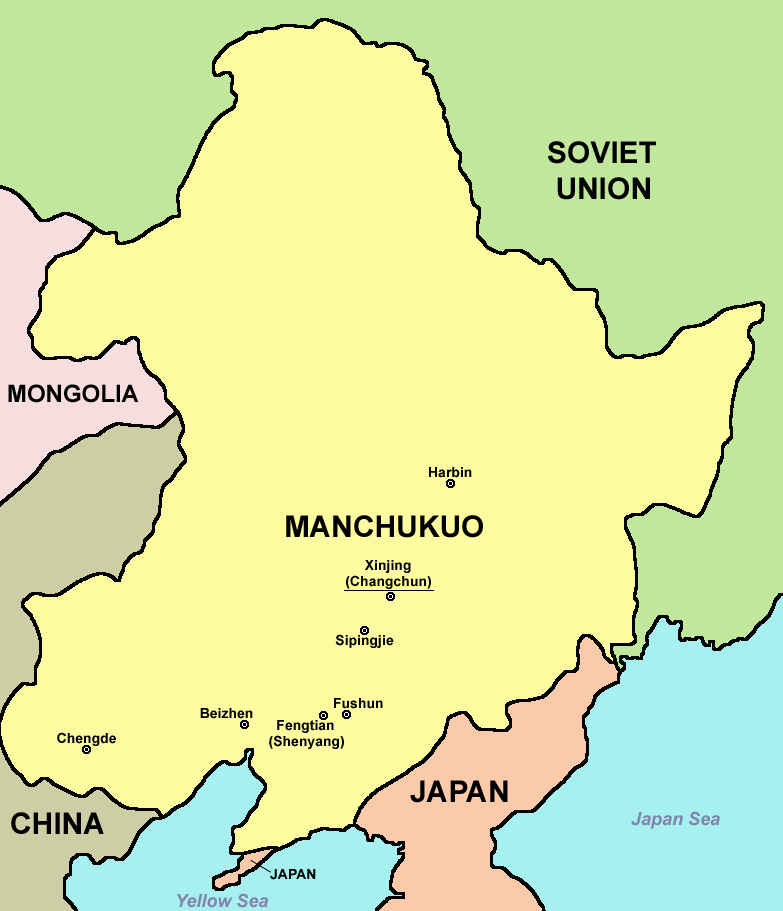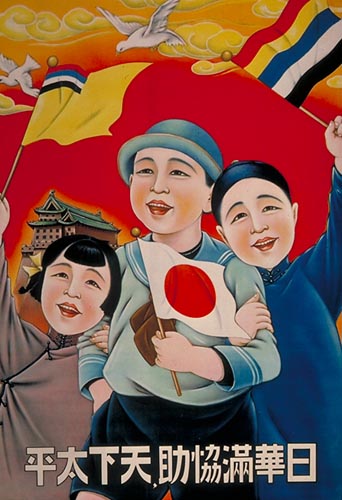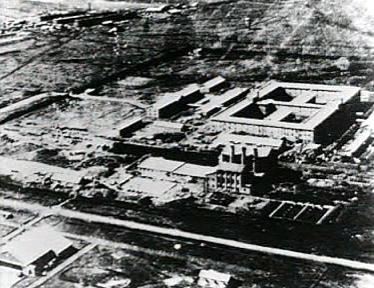JAPAN CREATES CHINESE PUPPET STATE
Hsinking (Changchun), Manchukuo · February 18, 1932
The Meiji Restoration of Imperial rule in 1868 resulted in the downfall of Japan’s powerful military commanders, the shoguns, and the Japanese samurai warrior class. Partly as a concession to the samurai, the Japanese government embarked on an aggressive foreign policy in Manchuria in northeastern China and on the Korean Peninsula. The Japanese defeat of Russia over the latter’s territorial ambitions in Manchuria in 1904–1905 bolstered Japan’s power, authority, and self-confidence in the Asia Pacific region. The Treaty of Versailles, which ended World War I, granted Japan rights and concessions in the Shantung Peninsula in northeastern China across the Yellow Sea from Korea, a Japanese colony since 1910. Using an argument similar to the Nazis’ mantra for Lebensraum in Eastern Europe, Japanese national extremists looked to China for living space. On September 18, 1931, Japan’s Kwantung Army in China invaded Manchuria and on this date in 1932 established the puppet state of Manchukuo, the army’s springboard for further aggression in China. In the same year the Imperial Japanese Army, with the blessings of Shōwa Emperor Hirohito (on the throne from 1926 to 1989), organized a secret research group in Manchukuo’s Pingfang district for the purpose of developing chemical and biological weapons to be used against the Chinese, Koreans, and other “inferior” peoples whose territory they, comparable to the Nazis in Europe, intended to conquer. Unit 731, whose headquarters’ design was that of a lumber mill, was the most notorious of these research laboratories, where diseases such as bubonic plague, cholera, and anthrax were mass-produced. More than 10,000 humans (euphemistically known as “logs”) were subjects of barbarous experiments conducted in this and similar factories of death, repeatedly being forced to work to exhaustion and exposed to diseases, starvation, and vivisection. Hapless subjects included criminals, bandits, anti-Japanese partisans, political prisoners, as well as infants, children, the elderly, and pregnant women. Run by the Kwantung Army, Unit 731’s victims also included U.S., British, Dutch, Australian, and Soviet prisoners of war. Unit 731’s germ and chemical weapons programs resulted in possibly as many as 200,000 gruesome deaths of military personnel and civilians between 1932 and 1945. Most of the perpetrators were never brought to justice after the war.
[amazon_carousel widget_type=”ASINList” width=”600″ height=”200″ title=”Recommended Reading” market_place=”US” shuffle_products=”False” show_border=”False” asin=”0415932149,0804835659,0060933879,0306811782,0813327180,1848844794,0415682282,0029353017,0742530914,0688143709″ /]
Japanese Puppet State Manchukuo (1932-1945) and Biological Warfare Unit 731
 |
Above: Map of Manchukuo (Manchuria) in relation to its neighbors. The large area labeled “Japan” is the Japanese colony of Korea (1910–1945). The smaller area on the southern part of the Liaodong Peninsula in Manchuria went by the name of Kwantung Leased Territory, which included the militarily and economically significant ports of Lüshunkou (Port Arthur) and Dalian.
 |  |
Left: Propaganda poster promoting harmony between Japanese, Chinese, and the residents of Manchukuo. The caption says (right to left): “With the cooperation of Japan, China, and Manchukuo, the world can be in peace.”
![]()
Right: Japanese Biological Warfare Unit 731 Headquarters at Pingfang (near Harbin), Manchukuo (Northeast China). Officially known as the Epidemic Prevention and Water Purification Department of the Kwantung Army (the Japanese occupation army in Manchukuo), the sprawling complex was serviced by an airport and railroad stations. Leading Japanese medical schools assigned doctors to Unit 731, some of whom later complained of wasting the best years of their lives on medical research that could not be continued after the war. Almost 70 percent of the victims who died in at Pingfang (there were other Unit 731 installations) were Chinese, including both civilian and military. Soviets comprised close to 30 percent of the victims. Most of Pingfang was burnt by the Japanese to destroy evidence of the some of the most grisly atrocities of World War II, but the incinerator where the remains of victims were burnt remains today. Unlike war crimes associated with Nazi human experimentation, which are extremely well documented, the activities of Unit 731 are known only from the testimonies of former unit members.
Unit 731—Nightmare in Manchuria (History Channel)
![]()

 History buffs, there is good news! The Daily Chronicles of World War II is now available as an ebook for $4.99 on Amazon.com. Containing a year’s worth of dated entries from this website, the ebook brings the story of this tumultuous era to life in a compelling, authoritative, and succinct manner. Featuring inventive navigation aids, the ebook enables readers to instantly move forward or backward by month and date to different dated entries. Simple and elegant! Click
History buffs, there is good news! The Daily Chronicles of World War II is now available as an ebook for $4.99 on Amazon.com. Containing a year’s worth of dated entries from this website, the ebook brings the story of this tumultuous era to life in a compelling, authoritative, and succinct manner. Featuring inventive navigation aids, the ebook enables readers to instantly move forward or backward by month and date to different dated entries. Simple and elegant! Click 











